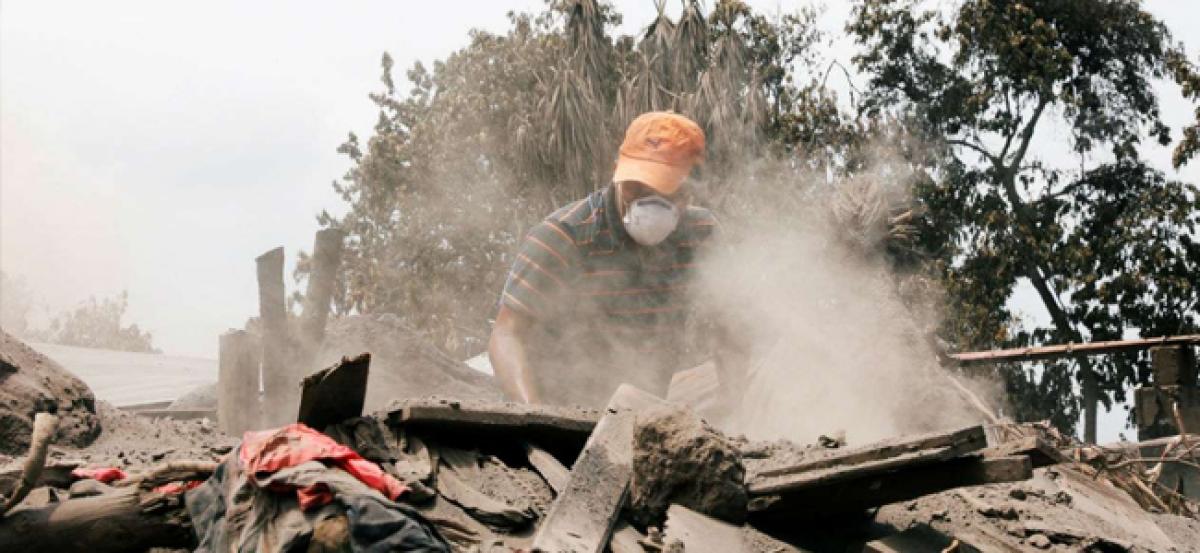Live
- Uddhav Thackeray to PM Modi: Pay attention to Bangladesh, act to end Hindus’ misery
- Allu Arjun Arrested: KTR Reacts on X, Calls Arrest Unfair
- Bold steps by Modi govt in reviving Indian heritage, culture: Union Minister
- What are the charges against Allu Arjun: Understanding the Charges Against Him
- Allu Arjun Objects to Arrest Procedure, Requests Breakfast and Change of Clothes
- ‘Fear’ movie review: A gripping suspense thriller
- Phenom Successfully Hosts IAMPHENOM India, Transforming the Future of Work with AI, Automation, and Talent Experience
- Constitution provides shied, guarantee to Indians: Priyanka in LS
- Allu Arjun’s Quash Petition Hearing at 2:30 PM; Chiranjeevi Visits Police Station
- Bommai hails 'One Nation, One Election' move as PM Modi’s bold decision
Just In

A communication breakdown between a disaster agency and volcanologists in Guatemala delayed evacuations as gas and ash clouds cascaded down the Fuego volcano last Sunday in its most violent eruption in four decades, authorities have admitted.
A communication breakdown between a disaster agency and volcanologists in Guatemala delayed evacuations as gas and ash clouds cascaded down the Fuego volcano last Sunday in its most violent eruption in four decades, authorities have admitted.
Compounding the situation, rain and clouds hid signs of the toxic shower of debris, known as a pyroclastic flow, hurtling down the mountainside, hindering visual observation.
The scalding material that poured out of Fuego, which means "Fire" in Spanish, has killed 100 people, with more than 190 missing, authorities say, as rescue work on Thursday was suspended as it was too dangerous for the workers.
Almost all the victims are from poor, coffee-growing hamlets on the mountain's lower slopes that are now partially buried.
By the time Pedro Morales, a field technician at Guatemala's disaster agency, caught sight of the debris flows, which can move at speeds of up to 190 miles per hour (300 kph), they were already drawing close to houses.
"When you could finally see it, it was underneath the rain cloud, on the low part very close to homes," he said.
"It was already too close to the town."
While the poor visibility delayed villagers' own reactions to the impending danger, 27 miles (43 km) away in Guatemala City, disaster authorities failed to understand the magnitude of the eruption, meaning the alert level leading to mandatory evacuations was not raised quickly enough, the heads of the responsible government agencies admitted on Wednesday.
That meant people were left in their homes for hours after the dangerous flows began and has led to opposition calls for criminal charges and resignations.
Guatemala's public prosecutor said on Thursday that it would open an investigation into whether protocols were followed to inform proper decision-making in the handling of the disaster.
In a tense meeting at Guatemala's Congress on Wednesday, the head of the country's volcanology institute accused his counterpart at disaster agency CONRED of failing to heed bulletins warning that Fuego was dangerously erupting.
CONRED chief Sergio Cabanas accepted the evacuation order was late, but blamed the volcanologists for not being explicit enough that the situation was dangerous.
The reports did not include enough details of the volcanic activity, and which communities it would affect, he said.
When asked if he had received a bulletin, he responded, "Sure, but it doesn't say anything."
The first bulletin from the volcanologists warned of pyroclastic flows descending from Fuego at 6 am (1200 GMT) on Sunday, some eight hours before the disaster agency seriously stepped up evacuation efforts.
Brandishing the morning bulletin, senior opposition lawmaker Mario Taracena accused Cabanas of incompetence, saying he bore criminal responsibility for the deaths.
"Anybody in this room with a bit of common sense would have done something," he said. "You are the head of the disaster agency and you didn't care."
Such institutional disorganization can be fatal, said Jeff Schlegelmilch, deputy director of Columbia University's National Center for Disaster Preparedness.
Disaster agencies need to focus on early-warning systems to avoid the scramble of split-second decisions once emergencies hit, he said.
"At the time that the volcano erupts, you only have what you have at that moment," he said. "Your plans are either there or they're not."
Chaotic evacuation
Families grappling to come to terms with the loss of life and homes in the hardest hit village, El Rodeo, on the south side of Fuego, also pointed fingers at the government for not doing more to warn them.
Construction worker Victor Martinez, 42, mourned the death of his friend, a pastor who was killed inside a village church buried under the ash. The pastor's five grandchildren also lost their lives.
"It's because of CONRED that so many families have died. They carry the responsibility for everything because they didn't get people out," he said, after digging for hours through the brown ash to retrieve audio equipment inside the church.
By the time evacuation orders reached the villages, the response was chaotic, and the flows were already bursting through the cloud shrouding the mountain.
"We saw people from CONRED passing by in their cars, but my wife only realized what was happening when people came fleeing," said electrician Jose Amilcar Acajabon Fuentes, 45.He and his wife joined the sprinting crowd and managed to get away.
Morales, the volcano expert, watched the disaster unfold after he was sent to monitor following the 6 a.m. bulletin. He said that in another village, an official hollered for residents to evacuate while weaving through the streets in a three-wheel taxi known as a "tuk-tuk."
Many locals eating lunch inside their homes either did not hear or ignored the warnings, while torrents of scorching rocks and fatal gases quietly raced closer.
"Pyroclastic flows don't make big sounds like an explosion," Morales said. "Pyroclastic flows are silent, but deadly."

© 2024 Hyderabad Media House Limited/The Hans India. All rights reserved. Powered by hocalwire.com







